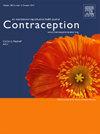COMPARISON OF SAFETY AND EFFICACY BETWEEN TELEMEDICINE AND CLINIC-BASED MEDICATION ABORTION AT A SINGLE ACADEMIC CENTER
IF 2.8
2区 医学
Q1 OBSTETRICS & GYNECOLOGY
引用次数: 0
Abstract
Objectives
Despite the rise in telemedicine medication abortion rates in the US, there is limited evidence comparing this model (NTMA) to traditional clinic-based medication abortion (CBMA). We aim to further the evidence around safety and efficacy of telemedicine medication abortion by comparing NTMA to CBMA to address the growing demand for abortion access.
Methods
We conducted a retrospective cohort study comparing safety and efficacy outcomes using electronic medical records for patients who either had a CBMA(n=800) or NTMA(n=171) up to 77 days of gestation between June 1, 2018 and December 31, 2022, at a large academic health center in California. Secondary outcomes included comparing completion rates of post-treatment follow-up and assessing the four-week home pregnancy test results for NTMA patients.
Results
A total of 91% of CBMA and 92% of NTMA patients had successful abortions without surgical intervention (p>0.05). After controlling for covariates, successful abortion rates did not statistically significantly differ by modality [adjusted OR (aOR) 1.10, p>0.05]. Less than 1% of both groups experienced an adverse event (p>0.05), with no missed ongoing or missed ectopic pregnancies for either modality. A greater proportion of NTMA patients completed a first follow-up visit compared to CBMA patients, although this difference was not statistically significant [aOR 1.78, p>0.05]. Approximately 18% of NTMA patients had positive pregnancy tests at a four-week follow-up appointment.
Conclusions
NTMA is an equally safe and effective abortion care model as CBMA. If not already offered, the provision of telemedicine medication abortion should be considered to meet the growing demand for abortion access.
在一个学术中心比较远程医疗和诊所药物流产的安全性和有效性
目的尽管美国远程医疗药物流产率有所上升,但将这种模式(NTMA)与传统诊所药物流产(CBMA)进行比较的证据却很有限。我们旨在通过比较 NTMA 与 CBMA,进一步证实远程医疗药物流产的安全性和有效性,以满足日益增长的流产需求。方法我们开展了一项回顾性队列研究,使用电子病历比较了加利福尼亚州一家大型学术健康中心在 2018 年 6 月 1 日至 2022 年 12 月 31 日期间妊娠 77 天以内接受 CBMA(n=800)或 NTMA(n=171)的患者的安全性和有效性结果。次要结果包括比较治疗后随访的完成率和评估NTMA患者四周后的家庭妊娠测试结果。结果共有91%的CBMA和92%的NTMA患者在没有手术干预的情况下成功流产(p>0.05)。控制协变量后,不同方式的成功流产率在统计学上无显著差异[调整OR (aOR) 1.10,p>0.05]。两组中均有不到1%的患者发生不良事件(p>0.05),两种方式均无漏诊持续妊娠或漏诊异位妊娠。与 CBMA 患者相比,完成首次随访的 NTMA 患者比例更高,但差异无统计学意义 [aOR 1.78,p>0.05]。约 18% 的 NTMA 患者在四周的随访中妊娠测试呈阳性。如果尚未提供远程医疗药物流产,则应考虑提供远程医疗药物流产,以满足日益增长的流产需求。
本文章由计算机程序翻译,如有差异,请以英文原文为准。
求助全文
约1分钟内获得全文
求助全文
来源期刊

Contraception
医学-妇产科学
CiteScore
4.70
自引率
17.20%
发文量
211
审稿时长
69 days
期刊介绍:
Contraception has an open access mirror journal Contraception: X, sharing the same aims and scope, editorial team, submission system and rigorous peer review.
The journal Contraception wishes to advance reproductive health through the rapid publication of the best and most interesting new scholarship regarding contraception and related fields such as abortion. The journal welcomes manuscripts from investigators working in the laboratory, clinical and social sciences, as well as public health and health professions education.
 求助内容:
求助内容: 应助结果提醒方式:
应助结果提醒方式:


